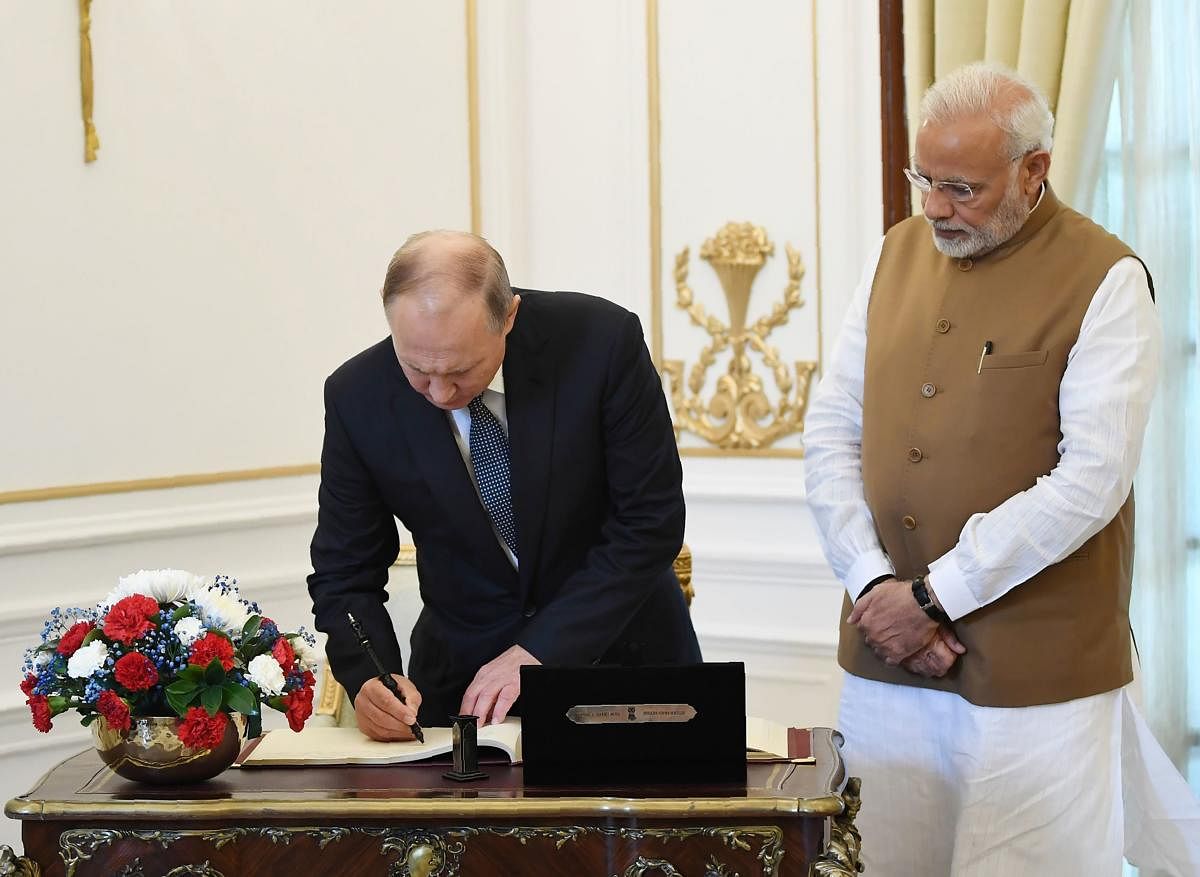
President Vladimir Putin and Prime Minister Narendra Modi signed eight agreements in areas including space, nuclear energy, small industries, railways, defence and others during the former’s two-day visit to India last week for the 19th India-Russia annual bilateral summit.
Certainly, one major highlight of Putin’s visit was the conclusion of the contract for the Indian purchase of the Russian S-400 air defence missile system. Apart from the fact that this missile system will help India boost its defences against China, which has also purchased the same system, it will also give the Indian military establishment a critical edge against Pakistan.
At the same time, this particular defence deal can remove the dark clouds hovering over the future direction of the military partnership between India and Russia. In fact, the two countries have faced serious turbulence in consolidating their “special and privileged strategic partnership.” One important factor in this regard is Russia’s warming up to Pakistan. Apart from the earlier defence agreements, Russia sold Pakistan four helicopters in August 2017. Today, Islamabad is in talks with Russia to buy the Sukhoi-35 fighter jets as well as T-90 tanks. India is also concerned about the transforming Russia-China military engagement.
On the other hand, there has been increasing discomfort among sections of Russian experts that India has been cozying up to the US, at the cost of its ties with Russia – a time-tested friend -- especially in view of India’s efforts to reduce its military dependence on Russia. The fact that the US has become the second largest arms supplier for India has not gone down well with Moscow.
Thus, Putin’s visit last week would have served to dispel to some extent India’s commitment to its ties with Russia, because New Delhi went ahead with the S-400 buy despite the risk of attracting American sanctions.
Since the US threat of sanctions must worry New Delhi that its increasing dependence on American arms can be used by Washington to force it to toe the US line, the Modi government must foster the continued strengthening of military ties with Russia. India also needs to ensure that Russia does not foster deeper engagement with China, because the emergence of an alliance among Moscow, Beijing and Islamabad would pose a grave security threat to India.
Delhi’s gesture should impress upon Putin not to engage with Pakistan in the military sphere nor sell arms and military hardware to China that could heighten India’s security concerns. Russia would not want to lose the opportunity to win a large number of military contracts under Delhi’s $250-billion military modernisation programme.
India and Russia’s joint declaration of their support to the Afghan government’s efforts for an Afghan-led, Afghan-owned national peace and reconciliation process is an encouraging development because in the past Russian policy towards Kabul has also caused concern in the Indian security establishment, as it did when in August this year, Putin proposed to hold peace talks with the Afghan Taliban. It was only after the Afghanistan government’s refusal to participate in any such meeting that Russian put off the conference.
India and Russia’s call for a political resolution of the conflict in Syria and effective implementation of the Joint Comprehensive Plan of Action (JCPOA) on the Iranian nuclear programme, too, were important as they underscored India’s displeasure at Trump’s Syria and Iran policies.
Economic cooperation
Another important pillar of India-Russia ties is economic cooperation. While bilateral trade between the two recorded $7.71 billion in 2016, the two sides have a long way to go to realise the full potential in this area. It is in this context that Delhi and Moscow have set a target of $30 billion in bilateral trade by 2025. To achieve this, while the two sides formed a CEOs’ forum and the two leaders attended the India-Russia Business Summit, sending a strong signal of the willingness and capacity of the business sectors in both countries to strengthen economic, trade and investment partnerships.
The Niti Aayog and the Russian Ministry of Economic Development will hold the first Strategic Economic Dialogue later in 2018 in Russia. The two sides supported the early launch of the Green Corridor project aimed at simplification of customs operations in respect of goods being transported between India and Russia. The two sides also agreed to expedite the process of the signing of a Free Trade Agreement between the Eurasian Economic Union and India and implementation of the International North South Transport Corridor.
Cooperation in the energy sector has also emerged as very important for the two countries. While several Russian and Indian energy companies are working together in Vankorneft and Taas-Yuryakh Neftegazodobycha in Russia, the two sides want to expand business ties in LNG.
The countries have also started consultations on the new Russian-designed nuclear power plant in India. These efforts help India to meet the energy challenge and boost its economic growth and development, while India’s increasing energy needs provides Russia an opportunity to boost its economy by selling gas and other energy resources. On the global and multilateral front, while the two countries work together in the UN, BRICS and G-20 groupings, the SCO, Asean and East Asia Summit Forum, India also needs Russia’s support on its UN Security Council seat ambition.
Putin’s visit has reset India-Russia ties and, given shared interests in the military, security, economic, energy and trade and commerce areas, it should be hoped that the two countries will begin to elevate ties to new heights.
(The writer is Research Fellow, Chennai Centre for China Studies)